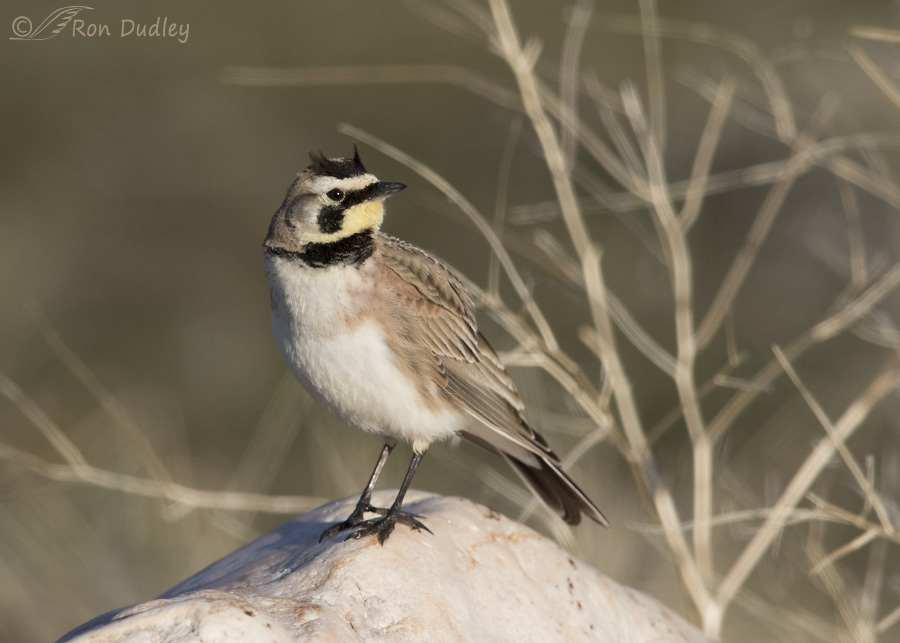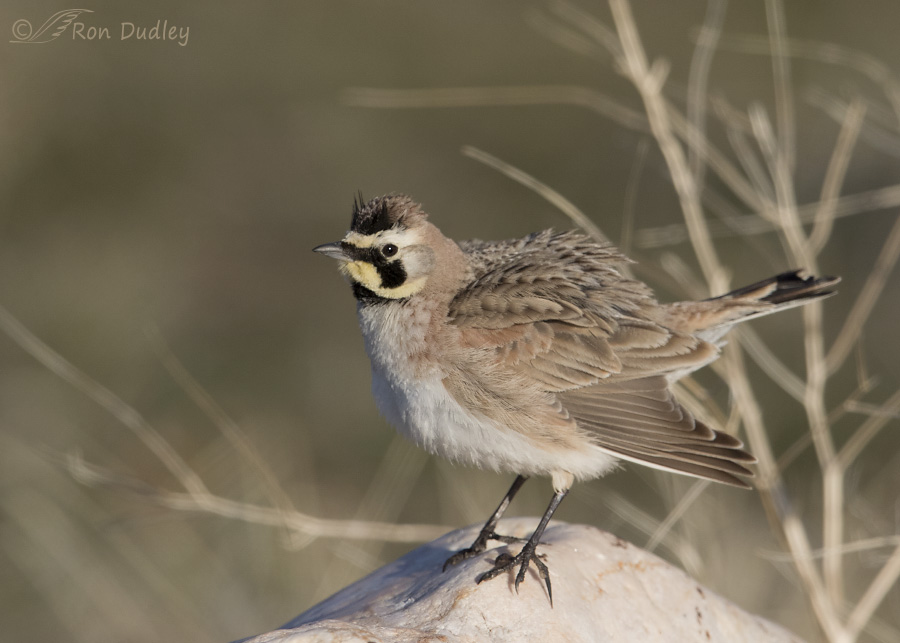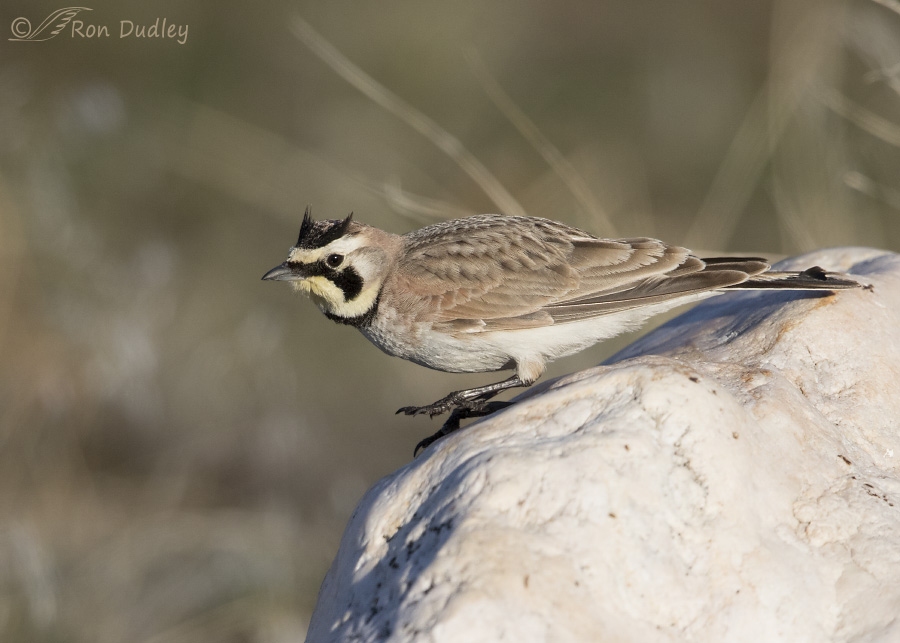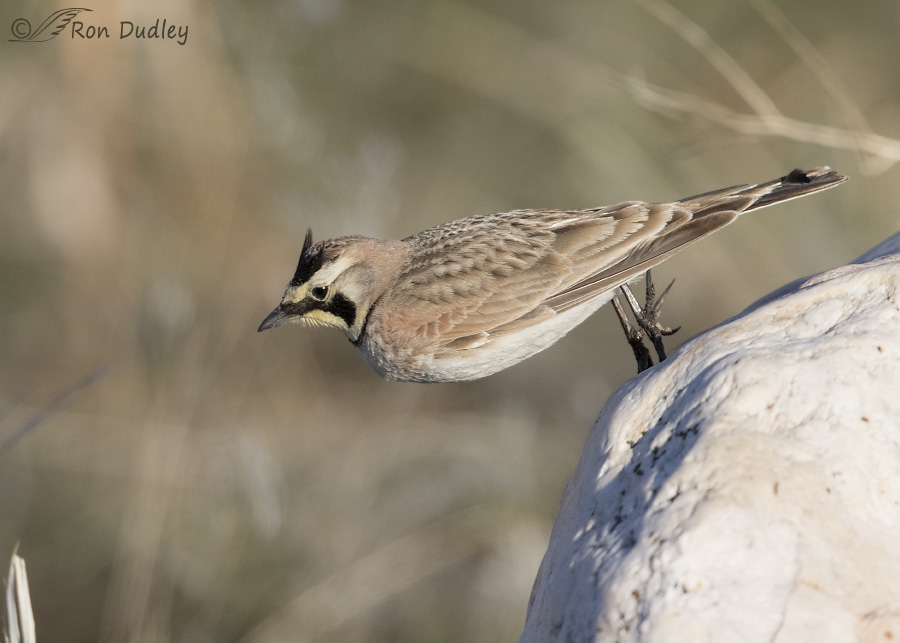Action shots of small birds are difficult to pull off well, partly because they’re so incredibly fast. Success usually requires appropriate photo gear, planning ahead, experience, luck, and lots of practice. Because I have many photo opportunities with Horned Larks I often choose them to practice on.

1/4000, f/6.3, ISO 800, Canon 7D Mark II, Canon EF 500mm f/4L IS II USM + 1.4 tc, not baited, set up or called in
I found this male two weeks ago on Antelope Island, Because the background is busy and I’m not fond of bright perches I decided to attempt to photograph any action he might present to me – mostly for the practice. So I upped my ISO to get sufficient shutter speed, left as much space in the frame as I could in the direction the bird was facing (or looking), tried to keep him in focus and waited for something interesting to happen.
It does take concentration. And patience.

1/3200, f/6.3, ISO 800, Canon 7D Mark II, Canon EF 500mm f/4L IS II USM + 1.4 tc, not baited, set up or called in
When he shook his feathers I was able to get 4 sharp shots of the action. The feather tips in particular move extremely fast during this process and usually the photographer doesn’t have enough shutter speed (especially in small birds) to get them sharp. Some folks prefer motion blur in images like this because it implies the movement that is actually occurring but my preference is usually to get them sharp. In this case I succeeded pretty well.

1/4000, f/6.3, ISO 800, Canon 7D Mark II, Canon EF 500mm f/4L IS II USM + 1.4 tc, not baited, set up or called in
These are twitchy, jumpy little birds and when this one headed for the edge of the rock to either take off or jump down to the ground I already had the shutter speed necessary to freeze his quick movements. If I hadn’t I’d have been out of luck because at this point I certainly didn’t have time to change any camera settings.

1/4000, f/6.3, ISO 800, Canon 7D Mark II, Canon EF 500mm f/4L IS II USM + 1.4 tc, not baited, set up or called in
The bird chose to jump to the ground and I don’t believe it even opened its wings during the descent. But since I had plenty of shutter speed to freeze the action and the bird jumped in the direction of my plane of focus the entire lark is sharp and that was my goal.
Did I get any spectacular shots from my efforts? No, but I added to my experience and to my knowledge base and that’s usually what it takes to improve your chances to get “that shot” when everything comes together sometime down the road.
Hopefully I’ll be ready for it next time it does. I’ve sure missed plenty of potentially wonderful shots because I wasn’t prepared.
Ron


I don’t think I’ve ever seen a horned lark. Thank you so much for sharing these, oh and insert the standard redundant Oh WOW! LOL!
The small birds are definitely feathered greased lightening aren’t they? And I find they are about as predictable as lightening too. Perhaps they will take off in the direction of their gaze – or then again…
I am so glad that you found patience and that you practise, practise, practise. Thank you.
“Perhaps they will take off in the direction of their gaze – or then again…”
That’s always the million dollar question, EC – which way will they go?
Great shots Ron. These birds are hard to photograph, or at least for me. They usually are hiding in the shrubs singing their beautiful song.
Thank you, Jean.
I have been practicing on the chickadees in my yard, so far a have nice foliage.
Ha, made me smile April, because it brought back so many memories of my own early frustrations.
Quick reflexes and anticipation of behavior also help (obviously). With enough experience under your belt you’ll begin to learn little indicators birds often give just before they take off or do something else interesting. When you see it happen, fire off a burst and cross your fingers!
But luck plays a huge part too so the more you try the better chance you have.
Interesting shots of an interesting little bird…easy to see how it got its name….seems like the smaller the bird, the quicker they move…either this bird was very cooperative or you and your equipment were extra fast…or all of the above!
“seems like the smaller the bird, the quicker they move”
That’s exactly right, Patty – one of the reasons you see very few shots of passerines in full flight (except for those who use setups…)
Ha, the key as you said is practice, practice and more practice, as well as patience. I’ve been told I have more patience with wildlife than with some humans! What can I say – guilty.
These shots are great and help us all as we try and work our craft. It is much appreciated that you take the time to talk and show the steps you go through as you prepare and press the button for the shot.
Dick – practice is the key. I remember when I first started shooting with a 500mm and how difficult it was for me to even FIND my subject in my viewfinder at those long focal lengths. It took a LOT of practice to learn to do it quickly – especially with birds in flight because with them you have very little search time.
I enjoyed these pictures a lot. The last one sure is a great example of keeping your eye on the target.
Carol
Even knowing “how to do it” it is always interesting to see your photos mostly because I’m very far from getting the results that you almost always achieve.
Thank you for sharing these great images.
Thanks, Jorge. Maybe the difference is that I have more practice time available than you probably do. I hope your retirement plans are still on track!
You are absolutely right I certainly need a lot of extra time.
As for the retirement plans they are on track but there is always a possibility that the Government change the rules.
I am keeping my fingers crossed…
Those shots really appeal to me for some reason, especially the one where the lark is rousing/shaking his feathers in such glorious detail. Maybe it’s because I have a simple mind and I’m easily amused? I dunno, but I loved the shots.
Thank you for the beautiful photos and for your dedication to this blog.
“Maybe it’s because I have a simple mind and I’m easily amused”
If so we share those two traits, Mark!
You mention the detail in the rousing shot – that’s why I prefer those types of images to be sharp rather than having motion blur. When they aren’t sharp you miss that detail.
I enjoyed learning about how you set these shots up. Thanks!
Good. It won’t be everyone’s cup of tea but I’m glad you found it interesting, Arwen.
Nice! Good to get the practice in on fast birds in less than ideal situations – you definitely have more patience than I do! A good reminder of what it takes. 🙂
“you definitely have more patience than I do”
Judy, all my life I’ve been known for my lack of patience. I guess it took bird photography to awaken that latent virtue in me…
Wonderful series Ron! The sharpness provides a great study in the feathers! I love the last shot. It’s screaming “there’s no turning back”!
Yup, it’s certainly too late to change his mind, Nancy!
Wonderful shots Ron!
Charlotte
Thanks, Charlotte.